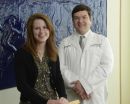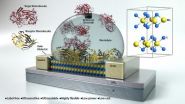(Press-News.org) DALLAS – Sept. 4, 2014 – Rare stem cells in testis that produce a biomarker protein called PAX7 help give rise to new sperm cells — and may hold a key to restoring fertility, research by scientists at UT Southwestern Medical Center suggests.
Researchers studying infertility in mouse models found that, unlike similar types of cells that develop into sperm, the stem cells that express PAX7 can survive treatment with toxic drugs and radiation. If the findings hold true in people, they eventually could lead to new strategies to restore or protect fertility in men undergoing cancer treatment.
"Unfortunately, many cancer treatments negatively impact fertility, and men who receive such treatments are at high risk of losing their fertility. This is of great concern among cancer patients," said Dr. Diego H. Castrillon, Associate Professor of Pathology and Director of Investigative Pathology. "The PAX7 stem cells we identified proved highly resistant to cancer treatments, suggesting that they may be the cells responsible for the recovery of fertility following such treatments."
Infertility, which the Centers for Disease Control estimates affects as many as 4.7 million men in the United States, is a key complication of cancer treatments, such as chemotherapy and radiation therapy.
The new findings, presented in the Journal of Clinical Investigation, provide valuable insight into the process of sperm development. Known as spermatogenesis, sperm development is driven by a population of "immature" stem cells called progenitors in the testes. These cells gradually "mature" into fully differentiated sperm cells. Dr. Castrillon and his team tracked progenitor cells that express the protein PAX7 in mouse testes, and found that these cells gradually give rise to mature sperm.
"We have long known that male fertility is driven by rare stem cells within the testes, but the precise identity of these stem cells has been disputed," said Dr. Castrillon, who holds the John H. Childers, M.D. Professorship in Pathology. "Our findings suggest that these rare PAX7 cells are the key cells within the testes that are ultimately responsible for male fertility."
Importantly, even after exposure to toxic chemotherapy or radiation treatments, the PAX7-expressing cells continued to divide and thus could contribute to restoring sperm development.
INFORMATION:
First author Gina Aloisio, a student in UT Southwestern's Medical Scientist Training Program, is the recipient of a Fellowship Award from the UT Southwestern Cecil H. and Ida Green Center for Reproductive Biology Sciences. Other UT Southwestern researchers involved in the work include Dr. Kent Hamra, Assistant Professor of Pharmacology; Dr. James Amatruda, Associate Professor of Pediatrics, Internal Medicine, and Molecular Biology, the Horchow Family Scholar in Pediatrics and holder of the Nearburg Family Professorship in Pediatric Oncology Research; Dr. Anita Sengupta, Assistant Professor of Pathology; Dr. Ileana Cuevas, Instructor of Pathology; Dr. Yuji Nakada, Instructor of Pathology; Abhijit Bugde, Department of Cell Biology; graduate student researchers Hatice Saatcioglu, Christopher Peña, and Hema Manjunath; and former UT Southwestern researchers Dr. Michael Baker, Dr. Edward Tarnawa, and Jishnu Mukherjee.
The work was sponsored by the David M. Crowley Foundation with additional support through grants from the National Cancer Institute and the State of Texas Norman Hackerman Advanced Research Program.
UT Southwestern's Harold C. Simmons Cancer Center is the only National Cancer Institute-designated cancer center in North Texas and one of just 66 NCI-designated cancer centers in the nation. The Harold C. Simmons Cancer Center includes 13 major cancer care programs with a focus on treating the whole patient with innovative treatments, while fostering groundbreaking basic research that has the potential to improve patient care and prevention of cancer worldwide. In addition, the Center's education and training programs support and develop the next generation of cancer researchers and clinicians.
Media Contact: Russell Rian
214-648-3404
russell.rian@utsouthwestern.edu
About UT Southwestern Medical Center
UT Southwestern, one of the premier academic medical centers in the nation, integrates pioneering biomedical research with exceptional clinical care and education. The institution's faculty includes many distinguished members, including six who have been awarded Nobel Prizes since 1985. Numbering more than 2,700, the faculty is responsible for groundbreaking medical advances and is committed to translating science-driven research quickly to new clinical treatments. UT Southwestern physicians provide medical care in 40 specialties to nearly 91,000 hospitalized patients and oversee more than 2 million outpatient visits a year.
This news release is available on our home page at
http://www.utsouthwestern.edu/home/news/index.html
To automatically receive news releases from UT Southwestern via email,
subscribe at http://www.utsouthwestern.edu/receivenews
Scientists identify rare stem cells that hold potential for infertility treatments
2014-09-04
ELSE PRESS RELEASES FROM THIS DATE:
Sugar substitutes not so super sweet after all
2014-09-04
The taste of common sugar substitutes is often described as being much more intense than sugar, but participants in a recent study indicated that these non-nutritive sugar substitutes are no sweeter than the real thing, according to Penn State food scientists.
In the study, participants compared the taste of non-nutritive sweeteners that are often used as low- or no-calorie sugar substitutes with those of nutritive sweeteners, such as sugar, maple syrup and agave nectar. The participants indicated they could perceive the non-nutritive sweeteners -- such as aspartame, ...
UCSB researchers develop ultra sensitive biosensor from molybdenite semiconductor
2014-09-04
Move over, graphene. An atomically thin, two-dimensional, ultrasensitive semiconductor material for biosensing developed by researchers at UC Santa Barbara promises to push the boundaries of biosensing technology in many fields, from health care to environmental protection to forensic industries.
Based on molybdenum disulfide or molybdenite (MoS2), the biosensor material — used commonly as a dry lubricant — surpasses graphene's already high sensitivity, offers better scalability and lends itself to high-volume manufacturing. Results of the researchers' study have been ...
A minimally invasive, high-performance intervention for staging lung cancer
2014-09-04
Endoscopic biopsy of lymph nodes between the two lungs (mediastinum) is a sensitive and accurate technique that can replace mediastinal surgery for staging lung cancer in patients with potentially resectable tumours. Such were the conclusions of a prospective controlled trial conducted under Dr. Moishe Liberman, a researcher at the CHUM Research Centre (CRCHUM) and an Associate Professor at the Université de Montréal. Moreover, the study showed that it is not necessary to perform surgery to confirm negative results obtained through the endoscopic approach during the pre-operative ...
Breakthrough study identifies genetic link between the circadian clock and seasonal timing
2014-09-04
Researchers from the University of Leicester have for the first time provided experimental evidence for a genetic link between two major timing mechanisms, the circadian clock and the seasonal timer.
New research from the Tauber laboratory at the University of Leicester, which will be published in the academic journal PLOS Genetics on 4 September, has corroborated previous observations that flies developed under short days become significantly more cold-resistant compared with flies raised in long-days, suggesting that this response can be used to study seasonal photoperiodic ...
The yin and yang of overcoming cocaine addiction
2014-09-04
PITTSBURGH—Yaoying Ma says that biology, by nature, has a yin and a yang—a push and a pull.
Addiction, particularly relapse, she finds, is no exception.
Ma is a research associate in the lab of Yan Dong, assistant professor of neuroscience in the University of Pittsburgh's Kenneth P. Dietrich School of Arts and Sciences. She is the lead author of a paper published online today in the journal Neuron that posits that it may be possible to ramp up an intrinsic anti-addiction response as a means to fight cocaine relapse and keep the wolves of relapse at bay.
This paper ...
A metallic alloy that is tough and ductile at cryogenic temperatures
2014-09-04
A new concept in metallic alloy design – called "high-entropy alloys" - has yielded a multiple-element material that not only tests out as one of the toughest on record, but, unlike most materials, the toughness as well as the strength and ductility of this alloy actually improves at cryogenic temperatures. This multi-element alloy was synthesized and tested through a collaboration of researchers at the U.S. Department of Energy (DOE)'s Lawrence Berkeley and Oak Ridge National Laboratories (Berkeley Lab and ORNL).
"We examined CrMnFeCoNi, a high-entropy alloy that contains ...
Rosetta-Alice spectrograph obtains first far ultraviolet spectra of a cometary surface
2014-09-04
Boulder, Colo. — Sept. 4, 2014 — NASA's Alice ultraviolet (UV) spectrograph aboard the European Space Agency's Rosetta comet orbiter has delivered its first scientific discoveries. Rosetta, in orbit around comet 67P/Churyumov-Gerasimenko, is the first spacecraft to study a comet up close.
As Alice began mapping the comet's surface last month, it made the first far ultraviolet spectra of a cometary surface. From these data, the Alice team discovered that the comet is unusually dark at ultraviolet wavelengths and that the comet's surface — so far — shows no large water-ice ...
Avian influenza virus isolated in harbor seals poses a threat to humans
2014-09-04
(MEMPHIS, Tenn. – September 4, 2014) A study led by St. Jude Children's Research Hospital scientists found the avian influenza A H3N8 virus that killed harbor seals along the New England coast can spread through respiratory droplets and poses a threat to humans. The research appears in the current issue of the scientific journal Nature Communications.
The avian H3N8 virus was isolated by scientists investigating the 2011 deaths of more than 160 harbor seals. Researchers discovered the virus had naturally acquired mutations in a key protein that previous laboratory research ...
2-D or 3-D? That is the question
2014-09-04
The increased visual realism of 3-D films is believed to offer viewers a more vivid and lifelike experience—more thrilling and intense than 2-D because it more closely approximates real life. However, psychology researchers at the University of Utah, among those who use film clips routinely in the lab to study patients' emotional conditions, have found that there is no significant difference between the two formats. The results were published recently in PLOS ONE.
The study aimed to validate the effectiveness of 3-D film, a newer technology, as compared to 2-D film that ...
Team identifies important regulators of immune cell response
2014-09-04
JUPITER, FL, September 4, 2014 - In a collaborative study, scientists from the Florida campus of The Scripps Research Institute (TSRI) and the La Jolla Institute for Allergy and Immunology have developed a more effective method to determine how immune cells called T cells differentiate into specialized types of cells that help eradicate infected cells and assist other immune cells during infection.
The new approach, published recently by the journal Immunity, could help accelerate laboratory research and the development of potential therapeutics, including vaccines. The ...




